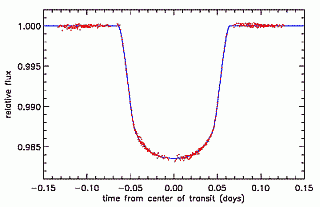EXTRASOLAR PLANET EXERCISE
Dr. Richard L. Bowman
Harrisonburg, Virginia 22802
(
richard.bowman@edtechbybowman.net )
Introduction
The actual discovery of extrasolar planets (or exoplanets) is
relatively new with the first such observation occurring in 1994.
since then this branch of research in astronomy has grown
dramatically. This exercise will introduce students to this area
of study--the techniques that may be used to find exoplanets, a
brief overview of what is now known, a simulation to acquaint
students with how the transit method works, and some plans for
future research projects.
Explorations
A. Getting Ready
1. Print out a copy of these worksheets for each member of the
lab group, unless your instructor has already made copies for
your use.
2. At the top-right corner of the first page, write your name
and the names of the persons in your lab group. Place
an asterisk by your name for identification purposes.
B. General Exoplanet Information
3. Go to
http://www.edtechbybowman.net/PhysAstroSims/exoplanets/ExoplanetEx.html
and read the introductory information. Click on the link for
"more info" and also check out the Kepler
mission site.
- What does David Koch, deputy principal investigator for
the Kepler Mission, say is special about the year 1996
with regard to finding exoplanets?
- List the three techniques used to find exoplanets.
Identify which technique will be used by the Kepler
mission.
- How many stars will the Kepler mission
monitor at any one time?
- The Kepler mission scheduled
for launch in what year and will last for how many years?
- ( True or False )
Exoplanets discovered to date are on the order of the
mass and size of Jupiter or larger.
[Circle the correct response.]
4. Next go to http://www.exoplanet.eu/
, "The Extrasolar Planets Encyclopedia" site.
- Read one of the latest news articles and write a two- or
three-sentence summary of this news.
- Explore the actual exoplanet catalog (the listing of the
currently known extrasolar planets). In the table below,
record the appropriate information for two different
stars and their exoplanets.
| Star Data |
Exoplanet Data |
| Name |
Mass
(solar mass) |
Apparent
Magnitude |
Mass |
Semi-major
Axis (AU) |
Orbital
Period (yr) |
| |
|
|
|
|
|
| |
|
|
|
|
|
- Are there any stars with more than one exoplanet? If so,
list one star's name and state how many planets are
currently known to orbit it.
C. Transit Method Simulation
5. At
http://www.edtechbybowman.net/PhysAstroSims/exoplanets/Transit-1.html
begin the "Finding Exoplanet" simulation. First time
through, do the default star (#1). Print out enough copies of the
last page of the simulation for each member of your lab group.
Then go back and run the simulation again for two more stars
printing out the last page, if possible, in each case.. (Only one
of these stars may be one of those for which an exoplanet cannot
be "observed." If this is the case simply record its
number here along with its spectral type.) Locate and copy the
appropriate information in the chart below.
| Star Number |
Probability of Finding
Exoplanet |
Is the Exoplanet in the
Habitable Zone? |
| |
|
|
| |
|
|
| |
|
|
D. More Exploration of the Transit Method
6. A triumph of the transit method occurred in 1999 when the
light curve of the star HD 209458 was shown to indicate the
presence of a large exoplanet in transit across its surface from
the perspective of Earth.(We still await results from the Kepler
Mission or other projects for evidence that Earth-size
planets exist around stars other than the Sun.) In addition to
providing a measure of the orbital period of the exoplanet about
its parent star, the light curve also provided data useful for
finding other information about the exoplanet such as its radius.
Subsequent spectroscopic studies with the Hubble Space Telescope
have even indicated that the exoplanet's atmosphere must have
sodium vapor in it.
| Star Data Apparent Mag.: 7.65
Spectral Type: G0
Radius: 1.146 Rsolar
Mass: 1.148 Msolar
|
Exoplanet Data Period: 3.52475
days
Semi-major Axis: 0.04747 AU
Radius: 1.38 RJupiter
Mass: 0.714 MJupiter
|
 |
| Source: Data summarized
at "The Extra-solar
Planets Encyclopedia,"
http://exoplanet.eu/star.php?st=HD+209458
. |
Source: Brown T., et al. The
Astrophysical Journal, 552, 699 (2000);
available through the "The Extrasolar Planets
Encyclopedia,"
http://exoplanet.eu/papers/HST-HD209458.pdf
. |
7. Above are some facts about the star and its exoplanet and a
refined light curve as recorded by the Hubble Space Telescope.
The upper-left corner at the beginning of the drop in the light
intensity curve occurred just as the leading edge of the
exoplanet began to move across the star and the upper-right
corner is just as the last edge of the exoplanet leaves from
being in front of the star.
- Assume that the orbit of the exoplanet moves directly
across the center of the star (this is not exactly true
but is a reasonable first approximation), on last page
of this worksheet, calculate the orbital speed of the
exoplanet at this point in its orbit in m/s. (Hint:
Remember that speed = distance/time.)
[Useful Data: Rsolar = 6.9599 X 108 m; Msolar
= 1.9889 X 1030 kg; RJupiter = 7.15 X 107
m; MJupiter = 1.8966 X 1027 kg]
Conclusion
8. Turn in your worksheet and the printouts of the results of
your simulation calculations. Staple them together with the worksheet on
top.
Bibliography
- Any good introductory college astronomy textbook such as:
John D. Fix.
Astronomy: Journey to the Cosmic Frontier,
6th ed. McGraw-Hill, 2011.
- More advanced topics are covered in introductory
astrophysics textbooks such as:.
William Zeilik and
Stephen A. Gregory. Introductory Astronomy and
Astrophysics, 4th ed. Fort Worth, Texas:
Saunders, 1998.
Return to Finding
Exoplanets Main page
Created and maintained by: Richard L. Bowman
(2004-12) (last updated: 23-Apr-12)
